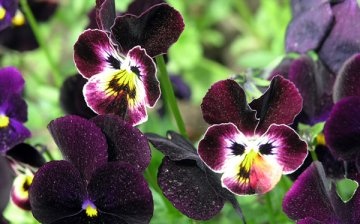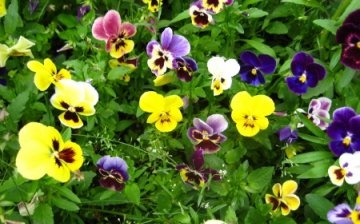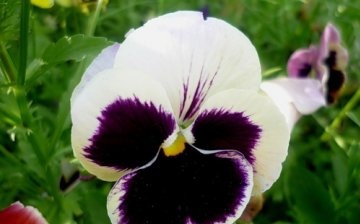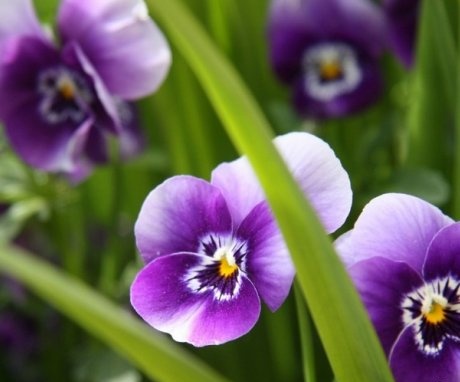Growing viola from seeds is done in several ways.
A beautiful garden plant, which has several names, one more sonorous than the other, fell in love with many flower growers. Viola, a tricolor violet (Viola tricolor), is popularly called pansies. In order for a plant to please for a long time with its spotted, contrasting or bright monochromatic color, you need to know about the features of its growth. Viola can be grown in a variety of ways, depending on climatic conditions and the intended flowering time.
Content:
- Viola as an annual plant
- Viola as a biennial plant
- Viola as a perennial plant
- Growing by cuttings
- Self-seeding cultivation
- Care features
Viola as an annual plant
Some varieties of viola do not tolerate low temperatures in the middle lane. Therefore, gardeners have to put more effort into decorating their own plot and use the method of annual crop cultivation.
In early spring, from about the end of February to mid-March, when the average daily temperature is + 10 degrees, a surface uniform sowing of seeds is carried out on closed ground with mandatory moisture. The containers are covered with cellophane or a glass cover and placed in a cool dark place.
If the temperature is too high (above +20 degrees), the seeds can "fall asleep". After 5-14 days, the seeds will germinate and with the appearance of the first leaves, they can be dived, leaving a distance of about 5 cm between young plants. Closer to the beginning of summer seedlings transplanted already into open ground. Viola tolerates transplant perfectly even during flowering.
From the end of June until the end of summer, pansies will delight with a friendly flowering. Some viola hybrid plants can bloom until frost.
Viola as a biennial plant
With this method of cultivation, the sowing of seeds takes place in June - early July in open ground. It might be cold greenhouse or exploration beds. In a period of 10 to 21 days, the plants sprout, they dive. When two full-fledged leaves appear, young plants are planted in the place of permanent cultivation at intervals of 20-25 cm from each other. This usually happens in August or early September. Plants should have time to develop well and gain strength before the cold weather arrives, but not bloom.
In order for the plants to safely endure the winter, they are mulched with sawdust, straw or spruce branches. Flowering will begin no earlier than mid-May. Not all plants will survive the subsequent wintering, and the remaining ones will become smaller, with elongated stems. To increase the decorative effect of the viola next year, it is recommended to cut the peduncles in October, leaving only the densest of them.
Viola as a perennial plant
If you want the plants to live for several years, you need to spend a short pruning overgrown and lost decorativeness of the bushes, leaving no more than 5 cm from the root. After this procedure, the plants are fertilized.
If you follow these simple recommendations, you can achieve abundant viola flowering over several years.
Growing by cuttings
A very simple and effective way to propagate viola is by cuttings carried out in the open field.In late May - early June, young green shoots are cut off from adult bushes, planted in a dark place with high density and shallow.
Cuttings actively take root in 3.5 weeks, and by the end of summer they will already bloom. If you carry out grafting later than June, the viola will bloom only the next year in the spring. The method of propagation by cuttings does not allow viola bushes to grow unnecessarily, rejuvenation occurs, contributing to more rapid flowering. In one summer season, one adult plant is capable of producing about 40 cuttings. This propagation method is used for especially valuable varieties.
Self-seeding cultivation
When the plant fades, a three-celled pod is formed. If the faded parts of the plant are removed in time, the viola will continue to bloom. Otherwise, the seeds ripen, they scatter on their own and will sprout next year. At the same time, the plant dies off, only a dried bush remains of it.
Seedlings can be removed from the beds by replanting them to other parts of the garden. Self-seeding does not give such excellent flowering results as other methods of growing viola, but it can facilitate the work of the gardener. It will not be possible to preserve the characteristics of the variety during self-sowing, therefore, you need to try to maintain a distance between different viola plantings of at least 100 m.
Care features
Viola can be planted not only in well-lit areas, but also in partial shade. At the same time, its flowering is longer, but the decorativeness of the plant suffers.
When planting pansies, you should try to avoid low-lying areas with stagnant melt water and areas with dry sandy soil. The plant grows well in moist fertile loams. Of the fertilizers, it is preferable to use complex potassium, nitrogen and phosphorus, for seedlings - ammonium nitrate and superphosphate. Viola does not tolerate feeding with fresh manure.
Pansies look very impressive as a curb plant. They are often decorated with alpine slides, they grow beautifully on balconies in boxes or flowerpots, they are pleasing to the eye at home on a windowsill in a flower pot. When cut, they stand for a long time and symbolize the flowers of love.














I've always liked pansies. At one time they grew up in our country house. I noticed that if these flowers grow from the seeds that are not harvested plants, then over time they become smaller.